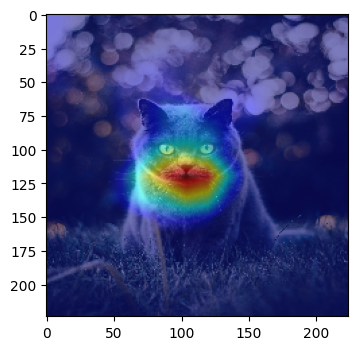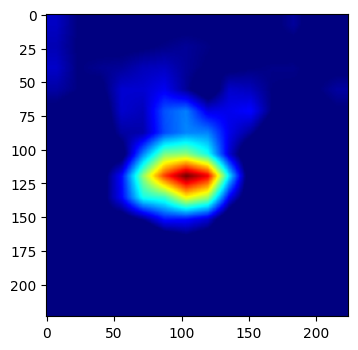VizGradCAM
VizGradCam is the fastest way to visualize GradCAM in Keras models. GradCAM helps with providing visual explainability of trained models and may serve as an important step in ensuring that engineers observe the regions that contributed to certain inference results.
Most tutorials or function features similar methods but requires the name of the last convolutional layer, performing the upscaling of heatmap and superimposing it on the original image. In this repository, we aim to combine all of those tasks.
Usage
This function can be imported or simply copied out into your script where required. Specific usage can be found in the sample Jupyter Notebook.
"""
Function Parameters:
model : Compiled Model with Weights Loaded
image : Image to Perform Inference On
plot_results : True - Function Plots using PLT
False - Returns Heatmap Array
interpolant : Interpolant Value that Describes The Superimposition Ratio
Between Image and Heatmap
"""
VizGradCAM(model, image, plot_results=True, interpolant=0.5)
Sample Usage
# Import Function
from gradcam import VizGradCAM
# Load Your Favourite Image
test_img = img_to_array(load_img("monkey.jpeg" , target_size=(224,224)))
# Use The Function - Boom!
VizGradCAM(EfficientNetB4(weights="imagenet"), test_img))
Results
plot_results=True |
plot_results=False |
|---|---|
 |
 |
More Information
This function is inspired by Keras' GradCAM tuturial here and the original paper, Grad-CAM: Visual Explanations from Deep Networks via Gradient-based Localization can be found here.
Tested / Supported Models
This function works with Keras CNN models and most Keras Applications / Based Models. This means that it will work even if you used include_top=False to add your own final dense layers for transfer learning on some of the models listed below. In GradCAM, we are looking to target gradients flowing into the last convolutional layer.
| Model Architecture | Support | Dimension |
|---|---|---|
| VGG16 | ✓ | (224,224) |
| VGG19 | ✓ | (224,224) |
| DenseNet121 | ✓ | (224,224) |
| DenseNet169 | ✓ | (224,224) |
| ResNet50 | ✓ | (224,224) |
| ResNet101 | ✓ | (224,224) |
| ResNet152 | ✓ | (224,224) |
| ResNet50V2 | ✓ | (224,224) |
| ResNet101V2 | ✓ | (224,224) |
| ResNet152V2 | ✓ | (224,224) |
| MobileNet | ✓ | (224,224) |
| MobileNetV2 | ✓ | (224,224) |
| Xception | ✓ | (299,299) |
| InceptionV3 | ✓ | (299,299) |
| InceptionResNetV2 | ✓ | (299,299) |
| EfficientNetB0 | ✓ | (224,224) |
| EfficientNetB1 | ✓ | (240,240) |
| EfficientNetB2 | ✓ | (260,260) |
| EfficientNetB3 | ✓ | (300,300) |
| EfficientNetB4 | ✓ | (380,380) |
| EfficientNetB5 | ✓ | (456,456) |
| EfficientNetB6 | ✓ | (528,528) |
| EfficientNetB7 | ✓ | (600,600) |








